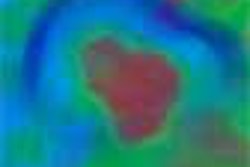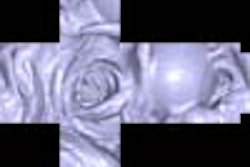While its incidence has been declining for several decades, pancreatic cancer is still expected to kill more than 30,000 Americans in 2003, making it the fourth-leading cause of cancer-related deaths. Five-year survival is a slim 4%, though early diagnosis and curative resection offer hope of long-term survival in those patients fortunate enough to manifest early symptoms such as jaundice.
CT, the gold standard for pancreatic cancer detection and staging, has been gaining ground in the difficult task of detecting cancers early enough to cure them, though it has generally been more accurate in proving unresectability than resectability. This is a good thing to the extent that it prevents unnecessary surgical intervention. But the goal is to maximize overall accuracy, and while sensitivity and specificity have certainly improved with the advent of thin-section multislice acquisition, differences of opinion still exist among researchers regarding the best methods of imaging suspected pancreatic adenocarcinoma with contrast-enhanced CT.
In this month's Radiology, Dr. Joel Fletcher, Dr. Maurits Wiersema, and colleagues from the Mayo Clinic in Rochester, MN, discussed their efforts to bring consensus to pancreatic CT protocols by examining the value of arterial, pancreatic, and hepatic-phase imaging for the detection of pancreatic malignancy using MDCT. The modality's faster scan times enable acquisition in all three arterial phases.
However, they wrote, it is important to ascertain that imaging in each of the three phases contributes to diagnosis; if imaging in a particular phase does not, then radiation dose is increased needlessly, and valuable scanner and interpretation time are wasted.
"Most authors advocate that the initial phase of the biphasic examination of the pancreas should be the pancreatic phase.... (which) allows optimization of tumor conspicuity, with maximization of tumor-to-pancreas attenuation differences, and allows adequate mesenteric venous and arterial opacification for detection of vascular invasion," they wrote. "A few authors advocate that the initial phase of the biphasic examination should be an earlier arterial phase. These authors believe that images obtained during the arterial phase allow increased tumor conspicuity and good visualization of the peripancreatic arterial supply, demonstrate pancreatic enhancement, and are superior to delayed-phase images. Others found that images obtained in the arterial phase were unhelpful" (Radiology, October 2003, Vol. 229:1, pp. 81-89).
In the study, the group performed triple-phase multidetector-row CT of the pancreas using a varying scale for the timing and injection rate and of each phase of enhancement, and timing each vascular phase on a sliding scale.
Patients drank 750 ml of water before the acquisition of triple-phase multidetector-row CT images of the pancreas using LightSpeed Plus and LightSpeed QX/I scanners (GE Medical Systems, Waukesha, WI). Section thickness and reconstruction interval were both 2.5 mm for each phase of enhancement. A 24-cm field of view, 0.8-second rotation time, high-speed mode, table speed of 15 mm per rotation, 140 kVp, and 200 mAs were used to acquire images during the arterial and pancreatic phases.
Hepatic-phase images were acquired with a field of view to fit, high-quality mode, 0.8-second rotation time, table speed of 7.5 mm per rotation, 140 kVp, and 190 mAs, the authors wrote.
Each image was interpreted by three of four experienced radiologists, with no reader interpreting more than one phase in any patient. They assessed the presence of lesions, and any findings that would suggest vascular invasion such as encasement, vessel margin irregularity, or incursion of the tumor into the periarterial fat plane with the tumor in juxtaposition to the vessel.
"Venous invasion was considered present when the tumor caused venous occlusion, flattening or narrowing, apposition with concavity toward the vessel lumen, or circumferential apposition greater than 180°," the authors wrote.
The readers also looked subjectively for flow artifacts in the mesenteric vein and measured the attenuation of tumors in each imaging phase on a GE Advantage Windows workstation, version 3.1 or 4.0. Tumor diagnoses were correlated with histology, follow-up, and correlative imaging findings, the authors reported, and attenuation differences in different phases of contrast enhancement were analyzed statistically with the paired Student t test.
Results
In all there were 33 tumors in 29 patients, 30 of which were pancreatic ductal adenocarcinomas. For the detection of pancreatic ductal adenocarcinoma only, sensitivity was 0.63 (19 of 30), 0.97 (29 of 30), and 0.93 (28 of 30) during the arterial, pancreatic, and hepatic phases, respectively, the authors wrote.
"The mean tumor-to-gland attenuation difference was the greatest on images obtained in the pancreatic phase (42 HU) versus that on those obtained in the hepatic phase (35 HU) and in the arterial phase (25 HU)...," they continued. "For tumor detection, sensitivity of the images obtained in pancreatic (0.97 [29 of 30]) and hepatic (0.93 [28 of 30]) phases was superior to that of those obtained in the pancreatic (0.58) and arterial (0.25) phases. The hepatic phase was most sensitive for the detection of vascular invasion (0.83) compared with pancreatic (0.58) and arterial (0.25) phases.
Increased flow artifacts and lower attenuation in the superior mesenteric vein were seen in images acquired during the pancreatic phase, compared with artifacts in the hepatic phase, which the authors considered still potentially useful.
"We found that images obtained in the pancreatic and hepatic phases may be complementary in a small number of patients in whom findings are equivocal on images obtained in one of these two phases," though interobserver variability could also explain the small differences, they wrote. "In approximately 70% of patients, maximal pancreatic enhancement was observed on images obtained in the pancreatic phase, and in a similar percentage maximal tumor-to-gland attenuation differences were demonstrated on images obtained in the pancreatic phase.... We conclude that it is unnecessary to acquire images in the arterial phase when one is searching for pancreatic ductal adenocarcinoma with a multidetector-row CT protocol."
Detection of arterial invasion was slightly better in the hepatic phase than in the pancreatic phase, they wrote. "As a result of these findings, we fail to find evidence to support the acquisition of images in the arterial and pancreatic phases for the staging of pancreatic ductal adenocarcinoma once a tumor has been identified on thin-section images obtained in the hepatic phase."
Thin-section (2.5 mm) imaging was also likely to have played a role in the finding of higher accuracy in the hepatic phase, they added. And the need for a second scan can be eliminated when a tumor is identified at routine MDCT screening in the hepatic phase.
"Eight- or 16-row scanners can retrospectively construct 2.5-mm thick sections from a routine scan in which 5.0-mm section thickness is used, thus allowing the creation of a thin-section dataset that could be used to predict vascular invasion with a high degree of accuracy," they wrote.
By Eric Barnes
AuntMinnie.com staff writer
October 27, 2003
Related Reading
Tumor marker useful in predicting pancreatic cancer resectability, October 2, 2003
High pitch, thin sections can optimize MDCT protocols, August 22, 2003
Ultrasound of the pancreas: what normal looks like, December 17, 2002
MRI with Teslascan preferred over CT for detection of pancreatic cancer, September 16, 2002
Copyright © 2003 AuntMinnie.com



















